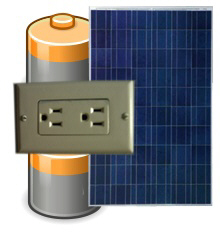 Living on the grid, it’s easy to forget about the importance of electricity in our everyday lives. That is, until there is a power outage, and suddenly our lives come crashing down to complete ineffectiveness. This is compounded if it happens during the evening/night, when light is needed.
Living on the grid, it’s easy to forget about the importance of electricity in our everyday lives. That is, until there is a power outage, and suddenly our lives come crashing down to complete ineffectiveness. This is compounded if it happens during the evening/night, when light is needed.
But there could be a simple and sustainable option in case of an emergency. And in the case of a remote location off the power grid, such as a cabin or a garden, it might prove to be a very workable solution to the lack of power. What is that alternative? A solar power station.
What Is A Solar Power Station
The typical solar power station will comprise of a high power solar panel, a charge controller, a storage battery, and a power inverter. Items can vary based on end use (for example, if you do not need AC power you can forgo the power inverter), but for most uses this defines what is required.
How Does It Work?
A solar power station is basically a stored repository of energy that has been collected over a period of time from the sun as well as a way to tap into energy that is collected at the moment of use. The basic theory of operation is like this:
- The high power solar panel(s) collect energy from the sun and uses it to power the charge controller.
- The charge controller takes the power from the panel and charges up the battery. The charge controller limits the charge to the battery so that the battery is adequately charged and maintained without damaging or overworking the battery cells.
- The battery (typically a deep cell 12 volts) is either directly tapped to a 12V outlet for DC applications or fed through the power inverter.
- The power inverter takes the 12 volts DC from the battery and creates ~110V AC power, as you would find from standard house current. This lets you use tools and items that would normally plug into a typical receptacle.
Now, the overall operation and design can vary based on the complexity of the solar power station used, but most commercial (and consumer built) units encompass this design.
Does A Solar Power Station Work Only In The Daytime?
A solar power station must at some point have the sunlight to charge its battery setup, but once that battery is charged the power can be used at any time, day or night. For most applications the unit will not absolutely require direct sunlight in order to charge (as in a hazy or cloudy day), but a strong sunlight location will result in the fastest charge cycle.
What Can I Power With A Solar Power Station?
A solar power station can power many small tools and appliances. Among those commonly used include:
- general lighting
- pond pumps
- drink blenders
- small kitchen appliances
- greenhouse heaters
- charging battery operated tools
- power computers and laptops
- charge phones and walkie talkies
- and more!
As you can see, the only limit to what you can use with a solar power station is your imagination and the application at hand.
How Long Will It Provide Power?
The length of time a given solar power station will provide power depends on several variables, including the size of the solar panel, the size of the battery, the amount of charge the battery has at the time of use, and the item being used. In a typical 150W Solar Panel setup using a 85ah battery, you can expect from 2-4 hours when powering the larger of the small appliances.
In the case of a less demanding item, such as some computers, LED based lighting, and telecommunications equipment, the time can be greatly extended. In some cases the total drain from the center is close to or less than the power the panel provides directly, in which case it can work all day without running empty.
As you can see, a solar power station might be the perfect way of having backup power for something on the grid, but it also works great as a solution where there is no power to start with. The important thing to note is that a solar power station is a sustainable solution that will work anywhere at any time, as long as it has enough sunlight to gather and store a charge.
A great way to compliment a solar power station, especially in a remote area, is to also have on site a water cistern to supply clean and fresh water for your needs. The combination of available power and fresh water can provide for many of the base needs in many projects, as well as making most of the comforts of home possible.
D. Salmons is a freelance writer and social media consultant for several companies, ranging from individuals to Fortune 500. She is a bit of a geek and enjoys writing about home improvement and going green over at www.diy-guides.com. She strives to reduce her carbon footprint and teach her son how to be environmentally aware and respectful of his environment.
Stay connected when the power’s out: browse our selection of crank radios.


solar ebike
Great article and explanations to get people motivated !